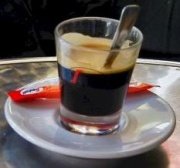- L'Espresso [1] is the name of an Italian magazine.
Espresso is a strong, flavorful coffee beverage brewed by forcing hot water through finely ground dark-roasted coffee beans. In Italian, espresso means "very quickly", and refers to the time it takes to make. The spelling "expresso" seen occasionally, is not correct.

Espresso appears dark brown with a gold-colored foam on top, and is often served in small portions.
Espresso differs greatly from the common drip brewed coffee drink in its thick concentrated consistency, and robust flavor. Due to its potency, straight espresso (espresso served without sweetener or milk, analogous to black coffee) is considered by some to be an acquired taste, and is served in small amounts called shots. Many coffee aficionados order their single or double with a little glass of cold water to clear the palate. Because the espresso reacts quickly with oxygen, it should be consumed right after brewing.
Espresso is considered the default coffee in Italy, therefore ordering a coffee (un caffè) means ordering an espresso: this confuses foreigners in Italy and Italians abroad alike. What is considered plain coffee outside Italy, is known in Italy as "caffè americano", and is rarely ordered by Italians.
Espresso is often used as the foundation for other drinks, such as lattes, cappuccinos, mochas, and many more. A key component in the flavor of espresso is a golden foam composed of oils, proteins, and sugars, called crema which floats on the surface.
Variations
- Lungo (long): more water (about double) is let through the ground coffee, giving a weaker taste. It is still definitely stronger than normal coffee outside Italy.
-
Ristretto (restricted): less water, yielding a stronger taste.
- Doppio (double): simply two espressos in one cup. In Italy, barmen that serve a lungo when ordered a doppio to save on coffee are frowned upon.
- Corretto (corrected): with some sort of liquor.
-
Americano (American): diluted with hot water.
-
Caffe' Macchiato (stained): with a drop of steamed milk
Espresso beans
Espresso is usually derived from a certain type of coffee bean; Coffea arabica, commonly known as Arabica, but the other variety, Robusta, is also used in some espresso blends. Arabica trees require more care in growing, and are therefore more expensive. Arabica beans are considered to be superior to the more common Coffea canephora (Robusta) beans, which are typically used for filler in commercial drip brew coffee. The roast of the beans varies from dark to light, depending on the desired taste. For making espresso, the beans are ground finely, unlike coarser drip-style grounds. The grind is achieved using a burr grinder, a type of grinder that uses two flat or conical burrs to grind the coffee to a fine even powder without heating it. However the beans are not ground very finely as in Turkish coffee, otherwise the powder will block coffee flow and prevent crema formation.
Brewing process
The process of making espresso is virtually an art form, and people who have mastered their technique are referred to as baristas, masters of many nuances which can be altered to affect the final product. High quality espresso machines can be too expensive for most people.
The act of producing a shot of espresso is colloquially termed "pulling" a shot. The term derives from older machines which required pulling a long handle to produce a shot. To pull a shot of espresso, a metal filter known as a portafilter is filled with approximately one tablespoon of properly ground espresso. The espresso is then tamped, or compressed into a densely packed puck of espresso. The portafilter is finally placed inside the grouphead and affixed into the espresso machine. When the machine is turned on, a pressurized stream of hot water is forced through the group head and through the portafilter, pulling the espresso into the shot glass to observe the shot and judge its quality.
Some individuals (and even accomplished baristas) prefer to pour right into a demitasse, a small cup used for espresso. This is because the heart and body of the shot will mix between 10-15 seconds after pulling the shot, resulting in a bitter flavor. Time is a critical element in pulling a decent shot, and a pull time which is too short or long will result in the shot either spraying out or dripping, rather than the molasses-like flow that produces the perfect shot.
Espresso was invented in Italy where it is said that four Ms are key to a good espresso: miscela (blend), macinazione (grind), macchina (machine), and mano (hand).
See also: Coffee, Coffee (drink), Espresso machine, Ristretto, Lungo , Cappuccino, Espresso con panna, Latte, Cortado, Mocha, Caffé, Coffeehouse, Demitasse, Drip brew, Moka.
External links
Last updated: 08-11-2005 23:05:44